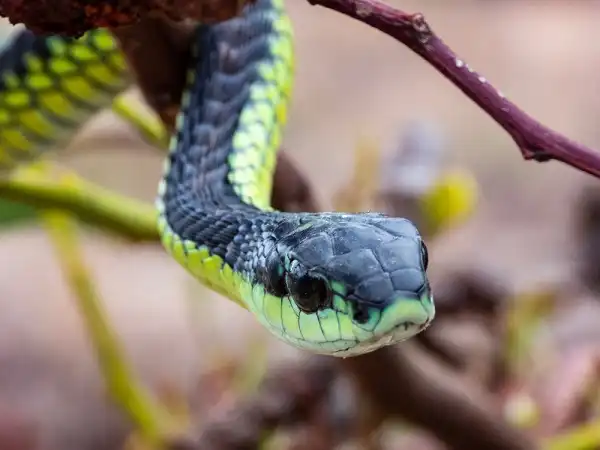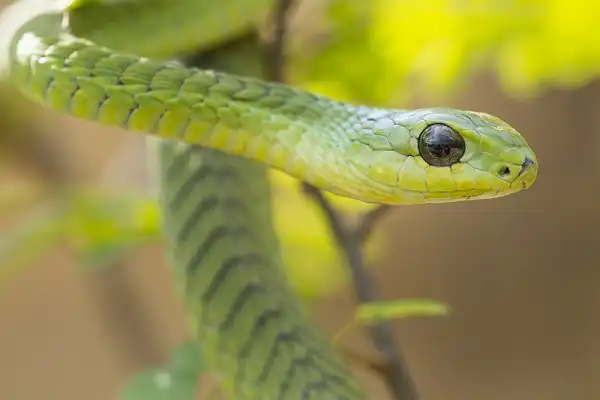The Boomslang is a venomous snake found in Africa. It is known for its aggressive behavior and powerful venom. Even though it is not the largest or most dangerous snake in Africa, it is still considered one be one of the most feared snakes on the continent. In this blog post, we will take a look at the Boomslang snake, its habitat, and what makes it so dangerous.

Boomslang Description
The Boomslang is a species of tree snake. It is an arboreal species that prefer habitats such as marshes, wetlands, savannas, and rainforest edges. It is usually found in the upper canopy of high trees though it may also be seen on the ground occasionally. The most distinctive feature of this species is its bright green eyes; this is due to the vertical pupils that can reduce glare from sunlight above them when they are perched on the treetops. The neck and head of boomslangs are proportionally larger than their bodies and have a flat, triangular shape with a pointed snout and small nostrils located at the end of the nose. They have long teeth which are used for gripping prey while injecting venom into it through two large grooved fangs at the back of their mouths.
Boomslang Habitat
The Boomslang is a species of tree snake found mainly in Sub-Saharan Africa, ranging from southern Senegal and the Gambia to Ethiopia, Somalia, and South Africa. It prefers habitats such as marshes, wetlands, savannas, and rainforest edges. The Boomslang’s chosen habitats have adequate sources of moisture like streams or rivers that provide ample access to water resources for drinking and reproduction. The trees in these areas are typically tall and offer a nice cover for climbing as well as greater options for prey spotting and ambush tactics when hunting. Since these snakes do not possess any thermal control abilities, they tend to bask more often than other species in order to maintain their body heat; this is why they can be easily spotted on tree branches during the day if one looks closely enough. The Boomslang’s natural habitat also has thick vegetation that allows them to retreat quickly into safety should they sense danger approaching or feel threatened by predators or humans that come too close. These snakes are nocturnal by nature thus avoiding direct sunlight; however, they still need enough light to spot their prey so favorite basking spots include areas near openings in the canopy where some sunlight can penetrate through.

Boomslang Diet
The Boomslang is an opportunistic predator, meaning it will feed on whatever prey is available. This usually consists of lizards, frogs, birds, small mammals, and other snakes. They have long teeth that are used for gripping the prey while injecting venom into it with two large grooved fangs at the back of their mouths. Boomslangs may also consume eggs or carrion when other food sources are scarce. Boomslangs possess a well-developed sense of smell which helps them locate small animals like frogs and lizards even in dense foliage or during nighttime; they are also believed to use vibrations from their prey to track them down. They prefer to remain hidden during the day, emerging at night to hunt in open areas such as clearings or near water bodies where visibility is greater and they can spot their prey easily. The Boomslang’s diet is varied depending on what is available throughout its range; especially in wetter regions where insects cannot survive for long periods of time due to humidity levels being too high for them to survive comfortably. Small rodents may also make up a significant portion of its diet although these tend to be consumed far less often than reptiles or amphibians due to their size making it difficult for boomslangs to overpower them efficiently with one strike from its venomous fangs.
Boomslang Size
The Boomslang is a medium-sized snake species native to Africa, that can reach an average length of between 40–60 cm (16–24 in). However, some specimens have been observed to reach lengths of up to 1.2 meters (4 feet). They usually have a bright green or yellow coloration with darker patches on the back and sides. Boomslangs also possess two large, curved fangs at the back of their mouths which are capable of delivering a deadly venomous bite. Both juvenile and adult boomslangs display different sizes depending on the individual species; for example, the Southern African boomslang is typically smaller than both the Eastern and Western varieties. Juveniles usually measure about 20 cm (7.87 in) in length and weigh 15-20 grams (0.5-0.7 ounces) while adults may reach up to 1 meter (3 feet) long and can weigh up to 200 grams (7 ounces). Their bodies are made up of around 200 vertebrae which give them great flexibility when it comes to both movement and maneuverability; this makes them adept climbers as well as excellent hunters who can easily move through dense foliage without being heard or noticed by potential prey until it is too late for them.
Boomslang Lifespan
Boomslangs have an average lifespan of 10 to 20 years, depending on the species; however, some specimens have been known to live up to 25 years. In captivity, boomslangs can live even longer due to a more consistent and regulated environment. The oldest recorded boomslang was 33 years old when it passed away in 2018. Generally speaking, boomslangs will reach maturity at around 3-4 years old and once this happens they become more resilient due to their stronger venom glands and increased muscle mass allowing them to better defend themselves from predators. This also boosts their longevity overall, as it helps them survive in the wild for longer periods without food or water if needed. However, since these snakes lack significant thermal control abilities they are prone to hypothermia during colder months which can greatly affect their lifespans if not addressed quickly enough; this is why many keepers recommend providing supplemental heating sources such as under-tank heaters during wintertime in order to ensure that their pets stay healthy and comfortable all year round.

Boomslang Behavior
Boomslangs are generally very shy and crepuscular, meaning they are active during the twilight hours of dawn and dusk. They will spend most of their time hiding in dense foliage or burrows in order to stay hidden from potential predators. During the day, they may be found basking on tree branches or logs in search of warmth and comfort. Although these snakes are not considered aggressive by nature if they feel threatened or mishandled they can become defensive and bite their aggressor. However, contrary to popular belief, boomslang bites are rarely fatal; rather, their venom acts as a powerful anticoagulant that causes severe internal bleeding which needs to be treated quickly with an antivenom for it to be effective. Overall, boomslangs are highly secretive yet fascinating creatures that require minimal care yet offer a lot of insight into a world filled with complexity and mystery. Their solitary nature ensures that owners don’t need to worry about maintaining two or more individuals but still enjoy watching them go about their daily lives in peace and harmony within their own environment – providing both entertainment and educational value at the same time!
Boomslang Speed
Boomslangs are relatively fast snakes and can move at top speeds of up to 4.5 miles per hour. This speed makes them quite capable of escaping predators, as well as catching their prey with ease. It has even been noted that boomslangs can outrun some other types of snakes in the same genus, such as cobras and adders. Their speed is aided by their slender body shape, which enables them to glide through dense foliage or narrow spaces with relative ease while their powerful muscles aid in propelling them forward with each movement. Additionally, they have the ability to turn quickly on a dime due to their agility and coordination, making it difficult for potential adversaries to catch them off, guard. When it comes down to it, boomslangs are remarkable creatures that possess incredible abilities when it comes to survival and adaptation in the wild. Their impressive speed grants them an advantage over potential predators as well as those unsuspecting prey that cross paths with these fascinating creatures. For this reason, one must admire not only their physical capabilities but also the precision and finesse with which they utilize these assets in order to survive day after day in the unforgiving wilderness of Africa!
Boomslang Hunting
Boomslangs are highly agile and efficient hunters, able to target and capture prey with remarkable accuracy and speed. In the wild, boomslangs will often hide in dense foliage and wait for unsuspecting animals to pass by before striking from a concealed location. Their powerful muscles enable them to rapidly launch themselves forward while their slender body shape allows them to move through the vegetation quickly and silently. Before striking, boomslangs will carefully observe their surroundings and assess any potential threats or obstacles that may be present. Once they have located a suitable target, these snakes will move swiftly towards it while slightly swaying their heads back and forth in order to maintain balance as well as pinpoint its exact location; this ability is aided by an excellent sense of smell which can detect prey from long distances.
Once the prey has been identified, boomslangs will open their mouth wide and lunge forward with their head before injecting venom into the victim through razor-sharp teeth designed specifically for this purpose. These bites usually contain a powerful anticoagulant that causes severe internal bleeding which needs to be treated quickly with an antivenom for it to be effective. However, this venom is also used as a means of subduing smaller animals such as rodents or birds, making them easier to eat without having to expend too much energy in the process. In addition to using venomous bites, boomslangs also employ a variety of other hunting tactics depending on the size of their intended prey. They are capable of climbing trees in search of eggs or baby birds while they can also dive underwater while pursuing aquatic animals such as frogs or fish. Boomslangs have even been known to ambush larger animals like antelope or gazelle when food is scarce; although these types of hunts are typically short-lived due to the snake’s small size compared to its potential victims!

Conclusion
In conclusion, boomslangs are remarkable creatures that possess an impressive array of physical capabilities and hunting tactics. Their speed and agility coupled with their keen sense of smell and accuracy make them some of the most efficient predators in Africa – allowing them to survive day after day without expending too much energy in the process! Boomslangs rely on these skills in order to catch unsuspecting prey or escape from potential dangers; however, they must always remain aware of their surroundings as a single misstep can easily lead to disaster. Regardless, one cannot help but admire the precision and finesse with which these snakes employ their amazing abilities in order to live free in the unforgiving wilderness!
Frequently Asked Question


